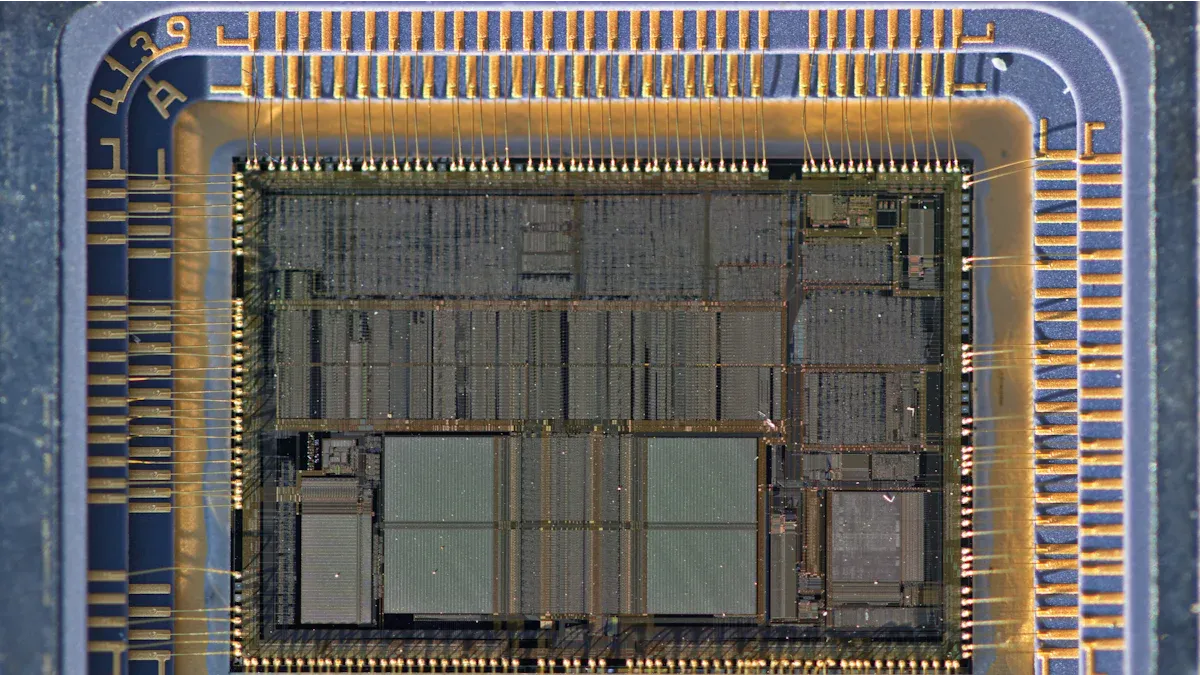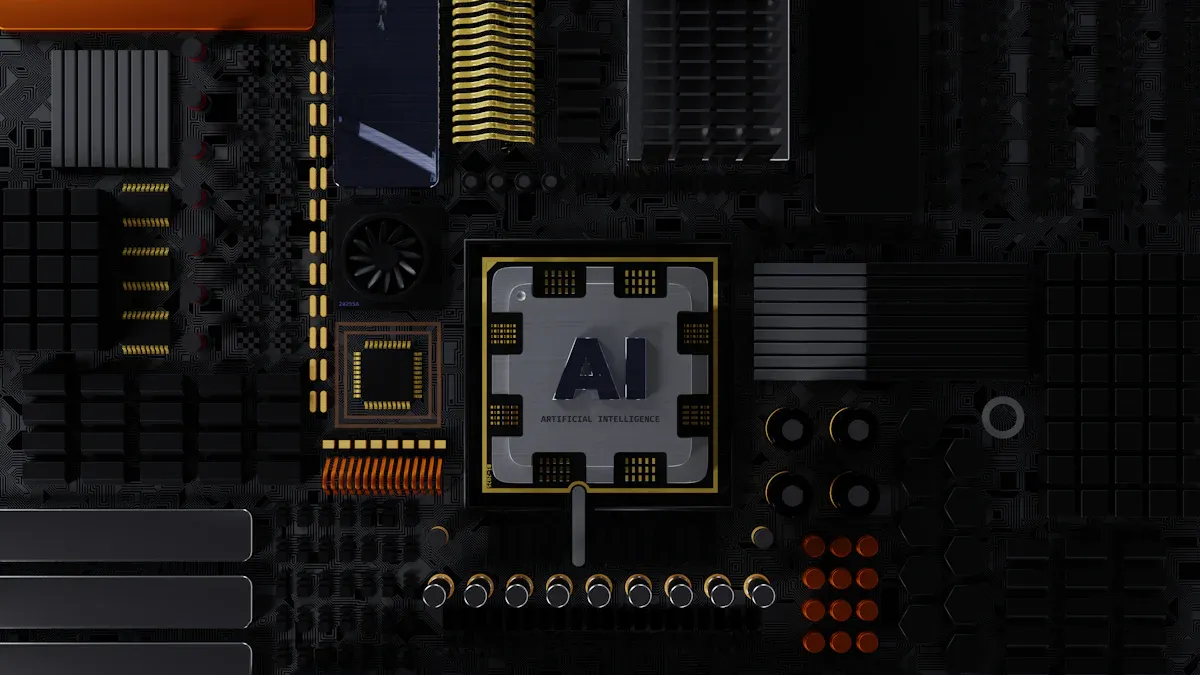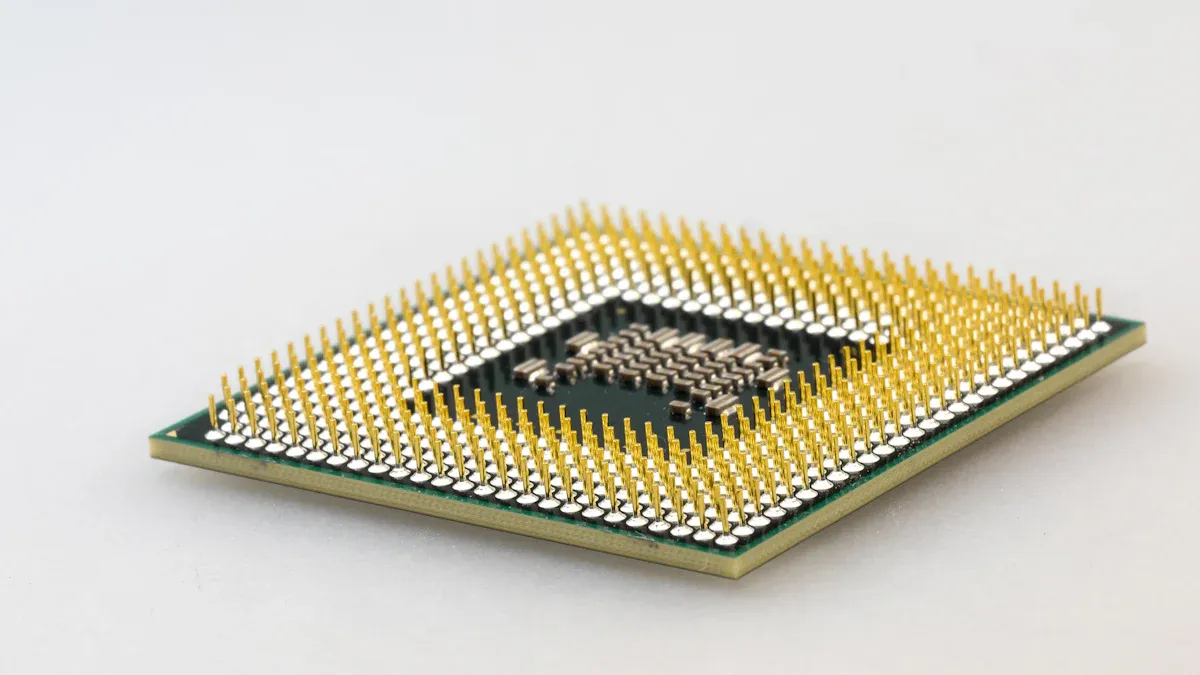What is a Fully Integrated Processor Chip and How Does it Work

A FULLY INTEG PROCESSOR chip combines essential computing elements—like the CPU, GPU, and memory—onto a single piece of silicon. This integration allows the chip to handle complex tasks efficiently and quickly. In modern electronics, these chips stand out because they use ultra-fast internal connections, support massive parallel processing, and manage power effectively.
They offer ultra-low latency for data movement.
Memory can scale independently, supporting larger workloads.
Thousands of cores operate together, making them ideal for demanding tasks.
These features make the chip powerful and reliable for devices that need high performance.
Key Takeaways
A fully integrated processor chip combines the CPU, GPU, memory, and other parts on one chip to make devices faster and more energy efficient.
These chips use smart designs like network-on-chip to move data quickly and reduce delays, helping devices run smoothly.
Power management and thermal control keep devices cool and extend battery life by using energy only when needed.
Fully integrated chips make devices smaller, cheaper, and more reliable by reducing the number of separate parts.
They power many devices like smartphones, cars, and data centers, improving performance in gaming, AI, and everyday tasks.
What Is a FULLY INTEG PROCESSOR Chip
Definition
A FULLY INTEG PROCESSOR chip brings together several important computing parts onto a single piece of silicon. This chip usually includes the central processing unit (CPU), graphics processing unit (GPU), memory, and other controllers. Many people call this type of chip a System on a Chip (SoC). The chip can run many tasks at once because all the parts work closely together.
Traditional computers often use separate chips for the CPU, GPU, and memory. These separate chips need to send data back and forth through longer paths, which can slow things down. A FULLY INTEG PROCESSOR chip puts everything in one place, so data moves faster and uses less power.
Apple’s M3 chip is a good example. It uses advanced 3nm technology and shows up to 35% better power efficiency and 15-20% higher performance than older chips. Many smartphones now use these chips because they help devices last longer and run cooler.
Key Features
A FULLY INTEG PROCESSOR chip stands out because of its smart design and strong performance. Here are some main features:
Combines CPU, GPU, memory, and other parts on one chip, making devices smaller and lighter.
Moves data quickly between parts, which helps apps and games run smoothly.
Uses less energy, so batteries last longer and devices stay cooler.
Reduces the number of parts inside a device, which lowers the chance of something breaking.
Makes it easier and cheaper to build devices because there are fewer pieces to put together.
Some case studies and market data show how these chips change the industry:
Apple’s M3 chip and other 3nm chips can improve battery life by up to 40% and reach peak energy efficiency of 91% in some processor families.
Over 100 million smartphones are expected to ship with 3nm integrated chips in 2024, and more than 80% of premium smartphones will use this technology by 2025.
Integrated chips help devices last longer because they create less heat and use less power.
The table below shows more details about the market and performance benefits:
Evidence Aspect | Details |
|---|---|
Market Size (2024) | |
Projected Market Size (2033) | USD 39.87 billion |
CAGR (2025-2033) | 6.10% |
Key Growth Drivers | Demand in smart consumer electronics, automotive, industrial IoT automation |
Performance Benefits | AI and ML integration, up to 50% energy reduction in AI-specific processors |
Regional Market Leaders | Asia-Pacific (highest revenue), North America (second largest) |
Industry Examples | Intel and AMD embedded processors in industrial, automotive, and consumer devices |
Energy Efficiency Impact | Semiconductor tech reduces energy use by up to 50% (SIA 2023 report) |
Government Support | US invests $7.5 billion in EV charging, boosting automotive processor demand |
AI and ML Trends | More AI accelerators and neural network processors in embedded systems |
A FULLY INTEG PROCESSOR chip changes how devices work by making them faster, more reliable, and more energy efficient. This design helps smartphones, tablets, cars, and many other devices perform better every year.
Components

A fully integrated processor chip contains several important parts. Each part has a special job. When engineers put all these parts on one chip, devices work faster and use less energy.
CPU
The CPU, or Central Processing Unit, acts as the brain of the chip. It handles most of the calculations and instructions. The CPU runs the operating system and controls how programs work. In a fully integrated chip, the CPU connects directly to other parts, which helps it process data quickly.
GPU
The GPU, or Graphics Processing Unit, manages images, videos, and graphics. It can handle many tasks at the same time. This makes it great for games, videos, and even some artificial intelligence tasks. When the GPU sits on the same chip as the CPU, it can share data faster and use less power.
Memory
Memory stores data and instructions that the CPU and GPU need. Most fully integrated chips use fast memory, such as LPDDR or HBM. This memory sits close to the CPU and GPU, so they can get information quickly. Devices can run more apps and switch between them smoothly because of this fast memory.
I/O
I/O stands for Input and Output. This part lets the chip talk to other devices, like screens, cameras, or storage. Integrated I/O means the chip can send and receive data without delays. For example, a smartphone can take a photo and save it right away because the I/O works fast.
Power Management
Power management controls how much energy each part of the chip uses. It helps the chip run cool and saves battery life. Smart power management can turn off parts of the chip when they are not needed. This makes devices last longer and stay safe.
Note: By combining all these components on one chip, engineers make devices smaller, faster, and more reliable. This design helps smartphones, tablets, and even cars work better every day.
How It Works

Internal Communication
A FULLY INTEG PROCESSOR chip uses advanced methods to help its parts talk to each other. In the past, chips used a shared bus system. This bus acted like a single road where all data traveled. ARM’s AMBA standard is a well-known example of this design. As chips became more complex, engineers found that the bus system could not keep up. Too many parts tried to use the same road, which caused slowdowns and higher power use.
Today, most chips use a network-on-chip (NoC) design. This system works more like a city map with many roads and intersections. Each part of the chip can send data along different paths. This design helps the chip move information faster and handle more tasks at once. Direct Memory Access (DMA) controllers also help by letting data move without always using the CPU. This increases the speed and lowers the workload on the main processor.
Modern chips use NoC designs for better speed and less delay.
DMA controllers help move data quickly by skipping the CPU.
NoC systems solve problems like wire delay and power use.
Chips include many interfaces and peripherals to help parts work together.
NoC designs make the chip more scalable. This means engineers can add more cores or features without slowing down the chip.
Data Processing
Each part of the chip has a special job. The CPU runs programs and makes decisions. The GPU handles graphics and complex math. Memory stores the data that these parts need. When a user opens an app, the CPU and GPU work together. They share data quickly because they sit close to each other on the chip.
The chip processes data in small steps. First, it takes in instructions from the user or software. Next, the CPU or GPU carries out these instructions. Memory provides the needed data right away. The chip can handle many tasks at once because all parts work together. This teamwork reduces the time it takes to finish jobs.
Devices like smartphones and tablets run smoothly because the chip can process data fast and switch between tasks with little delay.
Power and Thermal Control
Power management is a key part of how the chip works. Each part of the chip uses only the power it needs. When a part is not in use, the chip can turn it off or slow it down. This saves energy and keeps the device cool.
Thermal control helps the chip avoid overheating. Sensors watch the temperature inside the chip. If the chip gets too hot, it can lower its speed or turn off some parts. This keeps the device safe and helps it last longer.
Engineers use special materials and designs to help the chip stay cool. The integration of all parts on one chip means less energy is wasted as heat. This makes the FULLY INTEG PROCESSOR chip more efficient than older designs.
Good power and thermal control help devices run longer on a single charge and prevent damage from heat.
Advantages
Performance
Fully integrated processor chips deliver strong performance in many devices. Smartphones and tablets use these chips to run apps, games, and videos smoothly. The close connection between the CPU, GPU, and memory allows data to move quickly. This setup reduces delays and helps devices respond faster to user actions. For example, when someone opens a game on a phone, the chip can load graphics and process commands almost instantly. Performance benchmarks show that chips like Rock960 achieve fast execution times, making them ideal for tasks that need speed. These chips adapt to different workloads, so they work well in both simple and complex applications.
Efficiency
Efficiency stands out as a key benefit of fully integrated processor chips. These chips use less energy because all parts sit close together and share resources. In real-world tests, chips like Nezha D1 and Odroid XU4 show that performance per watt matters more than just low power use. Devices with these chips can run longer on a single battery charge. The integration of memory, communication interfaces, and processing cores also lowers power usage and heat. This design helps smartphones and tablets stay cool and last longer. Advanced processors, such as ARM Cortex-A cores, offer flexible and low-power solutions for many consumer electronics.
Size and Cost
Smaller chip size leads to many advantages. Devices become thinner and lighter, making them easier to carry. Manufacturers can fit more chips onto each silicon wafer, which lowers production costs. PPA (Power, Performance, Area) analysis helps engineers design chips that use less space and energy. This process also helps spot design flaws early, improving chip yield and reducing waste. Fewer parts inside a device mean less space is needed, so companies can make compact products at lower prices.
Reducing chip area directly lowers manufacturing costs by enabling more chips per wafer.
PPA analysis optimizes chip layout, making designs more cost-effective.
Early detection of design flaws improves yield and reliability, minimizing costly re-spins.
Reliability
Reliability improves when all parts of a processor sit on one chip. Fewer separate components mean fewer points of failure. Devices with integrated chips experience less electromagnetic interference, which helps them run smoothly. The reduced number of connections also lowers the risk of hardware problems. In consumer electronics and industrial automation, these chips help products last longer and require less maintenance. Users benefit from devices that work well over time, even with heavy use.
Applications of FULLY INTEG PROCESSOR Chips
Consumer Devices
Many people use devices powered by a FULLY INTEG PROCESSOR chip every day. Smartphones, tablets, and laptops rely on these chips to deliver fast performance and long battery life. Smartwatches and smart speakers also use integrated chips to run apps, play music, and connect to the internet. The demand for smaller, energy-efficient electronics continues to rise as more people buy smart devices. Companies design these chips to support advanced features like facial recognition, voice assistants, and high-quality video streaming. AI and machine learning tasks now run directly on consumer devices, making them smarter and more responsive. The growth in disposable incomes and internet use has pushed manufacturers to adopt these chips in almost all new gadgets.
Automotive and Industry
Car makers and industrial companies use fully integrated processor chips to improve safety and efficiency. Modern vehicles depend on these chips for advanced driver assistance systems (ADAS), which help with lane-keeping, automated braking, and adaptive cruise control. Tesla’s Autopilot and similar systems from other brands use AI-driven chips to process data from cameras and sensors in real time. These chips also support autonomous driving by handling computer vision tasks like object detection. In factories, integrated chips power edge computing devices that analyze data quickly and help with predictive maintenance. This technology reduces downtime and boosts productivity. Smart homes and industrial automation systems benefit from these chips by enabling better control and faster decision-making.
AI chips in cars and industry help machines see, think, and act faster, making roads and workplaces safer.
Data Centers and IoT
Data centers rely on fully integrated processor chips to handle massive workloads. These chips support cloud computing, big data analytics, and artificial intelligence. The global data center chip market is expected to grow from $14.3 billion in 2023 to nearly $58 billion by 2033. Companies like Intel, AMD, and Google lead the way with specialized chips for AI and machine learning. Cloud providers invested $270 billion in infrastructure in 2023, showing strong demand for advanced chips. The table below highlights key market insights:
Metric/Insight | Data/Value | Explanation/Context |
|---|---|---|
USD 21.2 Billion | Driven by cloud, AI, and analytics demand | |
2030 Projected Market Size | USD 42.7 Billion | Strong growth expected |
Processor Revenue Share (2024) | 42% | Processors dominate due to innovation |
Market Drivers | Cloud, AI, IoT | Fuel demand for high-performance integrated chips |
IoT devices in homes and industries also use these chips to process data locally, reducing delays and improving automation. As edge computing grows, the need for efficient, low-latency chips increases. This trend brings smarter devices closer to users and data sources.
A FULLY INTEG PROCESSOR chip combines the CPU, GPU, memory, and other parts on one chip. This design helps devices run faster and use less energy. Many modern gadgets, like smartphones and cars, depend on these chips for better performance. People see longer battery life and smoother operation.
Integrated chips shape the future of technology by making devices smarter and more efficient.
FAQ
What makes a fully integrated processor chip different from a regular processor?
A fully integrated processor chip combines the CPU, GPU, memory, and other parts on one chip. Regular processors often use separate chips for each part. This integration helps devices run faster and use less energy.
Can a fully integrated processor chip improve battery life?
Yes. These chips use less power because all parts sit close together. Devices with integrated chips often last longer on a single charge. Smart power management also helps save energy.
Where can people find fully integrated processor chips?
People can find these chips in smartphones, tablets, laptops, cars, and smart home devices. Many modern electronics use them for better speed and efficiency.
Are fully integrated processor chips good for gaming?
Yes. These chips handle graphics and data quickly. Gamers see smoother graphics and faster response times. Many gaming phones and tablets use integrated chips for better performance.
Do fully integrated processor chips support artificial intelligence (AI)?
They do. Many integrated chips include special parts for AI tasks. Devices can run voice assistants, facial recognition, and smart features directly on the chip.
See Also
Exploring The Functionality Of Fully Integrated Processors
Understanding How Computer Chips Operate And Function
A Guide To Programmable Logic Chips And Their Operation
The Importance Of Integrated Circuits In Today’s Electronics
